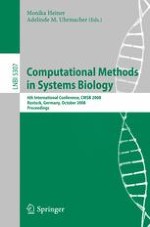This book constitutes the refereed proceedings of the 6th International Conference on Computational Methods in Systems Biology, CMSB 2008, held in Rostock, Germany, in September 2008. The 21 revised full papers presented together with the summaries of 5 invited papers were carefully reviewed and selected from more than 60 submissions. The papers cover theoretical or applied contributions that are motivated by a biological question focusing on modeling approaches, including process algebra, simulation approaches, analysis methods, in particular model checking and flux analysis, and case studies.
